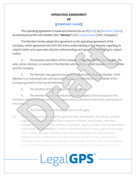Why Noncompetition Agreements Strengthen Asset Purchases
When you're buying or selling a business, there's a lot at stake. Asset purchase agreements help define the terms and avoid potential disputes or...
7 min read
LegalGPS : Jul. 24, 2024
Today, we're diving into the world of asset purchase agreements for multiple owners. As a business owner, it's essential to understand these agreements, especially if you're dealing with co-owners or partners.


Asset Purchase Agreement (Multiple Owners)
Download our Asset Purchase Agreement Template designed for transactions involving multiple owners. Customize it to suit your deal. Get started today!
Trusted by 1,000+ businesses to safeguard their LLCs.
Asset purchase agreements are crucial to any business transaction involving the transfer of assets from one entity to another. When you have multiple owners involved, though, things can get a bit more complicated. This guide will break down the ins and outs of asset purchase agreements for multiple owners, making this complex legal topic more digestible and actionable for the everyday entrepreneur.
An asset purchase agreement is a legal document that outlines the terms and conditions of a transaction involving the transfer of assets between two parties. These agreements are commonly used when one business acquires another or when businesses merge. The agreement typically includes the purchase price, a list of assets to be transferred, and the rights and obligations of each party.
An asset purchase agreement is essential for ensuring a smooth and legally sound transaction, which is why it's crucial that you understand how to create one.
When dealing with multiple owners, the need for an asset purchase agreement becomes even more critical. Here are a few reasons why:
When you have multiple owners, it's vital to establish a clear and legally binding division of assets and ownership. An asset purchase agreement provides a framework for documenting precisely who gets what, ensuring that all parties are on the same page and reducing the likelihood of disagreements down the line.
Disputes over assets and ownership are not uncommon in the world of business. An asset purchase agreement can help avoid these disputes by laying out the terms and conditions upfront, allowing all parties to understand and accept their obligations and rights before moving forward.
When a business is sold, merged, or otherwise transferred, its assets may be vulnerable to loss. A well-drafted asset purchase agreement can help protect these assets by outlining how they're to be transferred, ensuring that the proper legal processes are followed, and safeguarding your company's value.
In addition to identifying which assets are being sold, an asset purchase agreement can also specify the price and payment terms. By including all relevant details in your agreement, you can ensure that both parties are on the same page from the beginning and avoid any surprises or misunderstandings later on.
Transactional agreements for smooth business deals
The following are some of the key elements you'll want to include in your asset purchase agreement when dealing with multiple owners:
Asset List: Clearly define and list all of the assets being transferred, including real estate, equipment, inventory, intellectual property, customer lists, and more.
Purchase Price: Specify the total price of the assets and the allocation of the price among the different assets. This can have significant tax implications for both the buyer and the seller, so it's essential to be as detailed as possible.
Closing Date: Indicate the date upon which the transaction will be finalized and the assets officially transferred.
Assumption and Assignment of Contracts: Outline any contracts, leases, or other agreements that should be transferred to the new buyer, along with any required consents or approvals.
Representations and Warranties: These are statements made by both the buyer and the seller, guaranteeing certain aspects of the transaction, such as the assets' quality and the truthfulness of the parties' information.
Indemnification Provisions: These provisions protect the buyer and the seller from potential liabilities arising from the transaction by specifying the circumstances under which one party may be responsible for the other's losses.
Closing Conditions: Identify any conditions that must be fulfilled before the transaction can be completed, such as obtaining financing, consents from third parties, or regulatory approvals.
Being Vague: When crafting an asset purchase agreement, it's essential to be specific about the assets being transferred, the purchase price, and the responsibilities of each party. Being vague can lead to misunderstandings and disputes.
Failing to Properly Allocate the Purchase Price: As mentioned earlier, the allocation of the purchase price can have a significant impact on both the buyer's and seller's taxes. Ensure that the purchase price is appropriately allocated among the various assets to avoid potential tax issues.
Leaving Out Key Provisions: An incomplete agreement may prove inadequate in protecting your interests during the asset transfer process. Make sure you cover all essential clauses, such as representations and warranties, indemnification provisions, and closing conditions.
Failure to Consider Tax Consequences: The tax consequences of a sale can have a significant impact on the value of your business and the amount received at closing. Make sure you carefully consider the tax implications of any transaction and consult with an accountant or other financial professional before finalizing any agreement.


Legal GPS Pro
Protect your business with our complete legal subscription service, designed by top startup attorneys.
Now that you have a better understanding of asset purchase agreements, let's walk through the steps you'll need to follow when drafting one for your business with multiple owners.
Begin by compiling all the necessary information and documents, as they will form the backbone of your agreement. Here is what you need on hand:
A detailed list of all the assets involved in the transaction, including but not limited to physical property, equipment, customer lists, goodwill, and intellectual property.
Financial documents showing the value of these assets - they would typically involve records like balance sheets and valuation reports.
Any existing contracts, leases or agreements that are being transferred as part of the deal.
Make sure to be thorough and precise in this phase, as the quality of your agreement essentially depends on the accuracy and completeness of this information.
Example: If you’re transferring a car, make sure to include all relevant information about the vehicle in your agreement. This would typically involve things like:
The make and model of the car
The year it was manufactured
Details about color, condition, etc.
Any existing liens or loans on the vehicle
Get Your Asset Purchase Agreement Template
with a Legal GPS Subscription
Draft the terms of the agreement in conjunction with the other owners. This collaboration is key in creating an agreement that is fair and acceptable to all parties. The points to discuss should include:
Assets: Define and allocate each asset being transferred, and the proportion each owner will acquire. Ensure you discuss the value of each asset and how it contributes to the total purchase price.
Purchase Price and Payment Conditions: As multiple owners are involved, there should be a clear agreement on the share of the purchase price every owner is liable for, and when/how the payment is going to be made.
Liabilities: Vouch on the liabilities each party will bear after the transaction and have a clear strategy on how potential disputes will be resolved.
Remember, a fair agreement is where all parties feel reasonably satisfied and believe they got something good out of the deal.
Example: You are buying a property that has two owners. One is a relative, and the other is your friend. You have both agreed on the price and terms of sale, but you want to make sure there are no misunderstandings or disagreements down the road.
You draft an agreement that states: “The parties agree that this transaction shall be completed on [insert date] at [insert time]. The parties agree that the sale price of $[insert amount] is fair and reasonable, and that they will not seek to renegotiate this agreement. The seller agrees to convey legal title of his or her interest in the property by way of a quitclaim deed on [insert date] at [insert time].”
Start drafting the agreement using the information collated and discussed. Remember to spotlessly include:
Identifying the Parties: State the names and addresses of all the participating parties (buyers and sellers). First and foremost, everyone involved should know who else is part of the agreement.
Asset List: Include the detailed list of all the assets being transferred. Be exhaustive and account for tangible items, intangible assets including intellectual property rights, client lists, and contracts.
Purchase Price and Allocation: Clearly mention the agreed-upon purchase price for the assets. Specify how the price is allocated among the multiple owners and how ownership of each asset is divided.
Liabilities: State all liabilities each party agrees to take on as part of the transaction. Leave no room for ambiguity here, and explicitly state each liability like debt, unpaid accounts, pending litigation, etc.
Indemnification Provisions: Include provisions about cases in which one party will have to compensate the other(s) for financial harm or losses following the transaction.
Closing Conditions and Date: Define the conditions to be met before the deal can be finalized and the date when this happens.
Dispute Resolution: Finally, it's always wise to have protocols in place for resolving any disputes that arise from the agreement.
Once you have the draft ready, recheck all the elements to make sure nothing essential was missed out.
Example:
Indemnification by Seller: Seller will indemnify Buyer and its affiliates (collectively, "Buyer Indemnitees"), and hold them harmless from any claim, suit or action by any third party arising from the breach of this Agreement or related matters (including the sale of the assets), including but not limited to claims for personal injury, property damage and/or other damages to third parties resulting from Seller's actions or omissions.

Asset Purchase Agreement (Multiple Owners)
Download our Asset Purchase Agreement Template designed for transactions involving multiple owners. Customize it to suit your deal. Get started today!
Trusted by 1,000+ businesses to safeguard their LLCs.
Once all parties have reviewed the initial draft, make any necessary amendments.
After all revisions are completed, it's time for every party to sign the agreement. This process should be carried out in the presence of an external witness and all buyers and sellers should get a signed copy of the agreement.
Doing it yourself can feel overwhelming, but with careful precision and open communication between owners, drafting your asset purchase agreement becomes more manageable. Most importantly, remember that you are safeguarding the interests of all involved parties, and laying down a solid foundation for your business's future.
What happens if one of the owners doesn't agree with the terms of the asset purchase agreement?
It's crucial to have all owners on board when drafting an asset purchase agreement. In the event of a disagreement, it's essential to engage in open and transparent communication to find a solution that works for all parties involved.
How do you value the assets being transferred?
Valuations can vary depending on the specific assets in question. Typically, a combination of methods, such as market value, replacement value, and discounted cash flow, are used to determine a fair and accurate valuation.
Can I modify the asset purchase agreement after it has been signed?
It's possible to make changes to an agreement after it's been signed, but all parties must agree to these modifications and sign an amendment reflecting the changes.
Asset purchase agreements can be challenging, especially when dealing with multiple owners. By understanding the key components and following the step-by-step guide provided, you'll be well on your way to creating a solid agreement that safeguards your business's assets. And remember, our contract templates are just a click away, ready to save you time and deliver peace of mind. Good luck!
Get Legal GPS's Asset Purchase Agreement Template Now
The biggest question now is, "Do I need a business lawyer?” For most businesses and in most cases, you don't need a lawyer to start your business. Instead, many business owners rely on Legal GPS Pro to help with legal issues.
Legal GPS Pro is your All-In-One Legal Toolkit for Businesses. Developed by top startup attorneys, Pro gives you access to 100+ expertly crafted templates including operating agreements, NDAs, and service agreements, and an interactive platform. All designed to protect your company and set it up for lasting success.

Legal GPS Pro
Protect your business with our complete legal subscription service, designed by top startup attorneys.
|
Premium Template
Single-use Template |
Legal GPS Pro
Unlimited Access, Best Value |
|
|
| Choose Template | Learn More |
| Trusted by 1000+ businesses | |

When you're buying or selling a business, there's a lot at stake. Asset purchase agreements help define the terms and avoid potential disputes or...

Navigating the complex world of legal documents and contracts can be intimidating, especially for business owners without a legal background. But it...

You're venturing into new business territory, planning to seal a deal, or eyeing a new professional opportunity, and the phrase "Letter of Intent"...